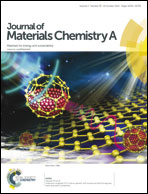Highly selective CO2 separation membranes through tunable poly(4-vinylphenolate)–CO2 interactions†
Abstract
A series of phenolate-containing polyelectrolytes were prepared via post-polymerization treatment of poly(4-vinylphenol) with tetraalkylphosphonium hydroxides (tetrabutylphosphonium hydroxide [P4444][OH], tributyltetradecylphosphonium hydroxide [P44414][OH] and trihexyltetradecylphosphonium hydroxide [P66614][OH]) or with tributylmethylphosphonium methylcarbonate [P4441][CO3CH3]. Also, mono- and dimethoxy-substituted vinylphenols were synthesized, polymerized and treated with [P66614][OH] to gain the corresponding polyelectrolytes. CO2 absorption capacity was measured as a function of the cation species and as a function of methoxy-substituents at the phenyl ring. ATR-IR and 13C MAS NMR spectroscopy confirmed chemisorption of CO2via formation of a phenol–carbonate complex at room temperature and 1 bar CO2 partial pressure. The introduction of an oligo(ethylene glycol) methacrylate co-monomer proved to suppress the formation of crystalline domains in the resulting material, enhancing CO2 absorption capacity and thin film stability. The polyelectrolytes reached a reversible CO2 absorption capacity of up to 0.65 in terms of CO2 molecule per phenolate group at 35 °C and 1 bar CO2 pressure, making them promising candidates for CO2-selective polymeric membrane materials. Thin coatings of the polyelectrolytes atop of a polysiloxane-based membrane support exhibited excellent adhesion and homogeneity as well as a highly competitive ideal CO2/N2 permeability selectivity of up to 67.7 at 15 °C and 1 bar transmembrane pressure.


 Please wait while we load your content...
Please wait while we load your content...